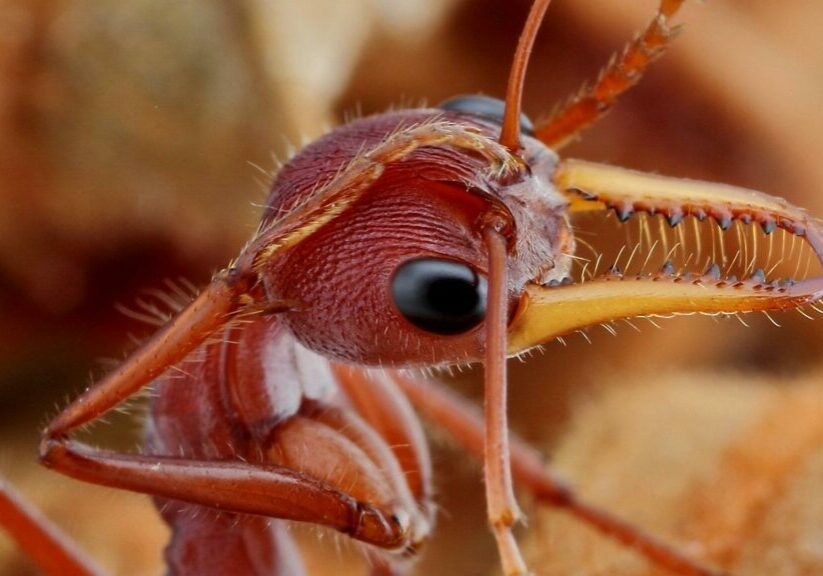Different pests, one approach: IPM
Whether you’re in an urban school where roaches and rodents are problems, or a rural school more concerned with weeds and dandelions on the grounds or athletic fields, the approach to pests should be the same: integrated pest management, or IPM. It’s a safer, cheaper and more effective way to manage pests than scheduled spraying. It’s also the law.
Pests are often less harmful than pesticides
While many of us cringe when we see bugs, we shouldn’t reach for a spray can—which, in fact, is illegal in schools in New Jersey. Some bugs do pose hazards, notably cockroaches, with feces that can exacerbate asthma, and mice, with droppings and urine that are associated with allergies and asthma. Mice also carry some serious diseases. But most insects will not harm us.
On the other hand, pesticides— including insecticides, rodenticides, fungicides, and herbicides—may be extremely toxic, especially when airborne because of spraying or misting. Many pesticides commonly used in schools are associated with nervous system damage, kidney and liver damage, allergies, and asthma. Some are associated with cancer and reproductive effects. Even when used outdoors, pesticides may be drawn into the building through the ventilation system or univents.
Integrated pest management
The New Jersey School Integrated Pest Management (IPM) Act was passed in 2002 and went into effect in 2004, mandating IPM. The idea is to first take measures to exclude pests, such as repairing holes, cracks and water leaks in the school structure and getting rid of the food, water, and shelter that pests need to survive.
If pests persist, then a stepped approach must be taken to reduce their numbers to a pre-determined acceptable level, or action level. The fi rst step involves glue traps or other devices that will not cause toxic chemicals to come into contact with people, only pests. More hazardous measures, such as sprays or mists, are only used as a last resort, and these should be of as low toxicity as possible.
Other key requirements of the law include:
- Each district must designate an IPM Coordinator, and develop school-specific IPM policies that consider the particuar pests at each school, and are consistent with the model IPM Policy developed by New Jersey Department of Environmental Protection (NJDEP) and Rutgers Cooperative Extension.
- Annual notifi cation of the school’s IPM Policy to all staff and parents, including all pesticides in use.
- For a high-impact (volatile or airborne) pesticide application: Prior notifi ation of all staff and parents including posting warning signs 72 hours in advance. Staff and students must be out of the building, and return only after the pesticide-specific re-entry time. If there is no stated re-entry time, return must be after at least seven hours.
- Documentation of all pest-control measures taken.
- Annual training for the IPM coordinator.
According to the NJDEP, most schools are compliant with the general stepwise approach. High impact/ high toxicity pesticides are rarely used now, but are occasionally applied, most commonly outdoors. The most common noncompliance issues are:
- Failure to document IPM history, notably prior to any chemical application.
- Failure to conduct monitoring, which involves regular site inspections to determine the types and quantities of pests at each site, before and after steps are taken to reduce their numbers.
Pests are part of broader problems
Scores of schools need new roofs or structural repairs. As deterioration worsens, water infi ltration brings mold and conditions favorable to insects and rodents. Yet building repairs—the fi rst step of IPM—were put on hold by Gov. Chris Christie when he took offi ce in 2010, even those emergency repairs for which the legislature had already approved funds.
The Christie administration claims lack of funds, but gave a billion dollars in tax credits and loopholes to corporations.
Christie’s lack of social spending exacerbates poverty and its attendent problems. For example, underfunded low-income housing subjects lots of urban students to lice, which may jump to classmates at school; to roaches which may hitch a ride to school in a bookbag; and to bedbugs. Eradicating pests in large apartment complexes is diffi cult and expensive, and would require state spending.
What local associations can do
In each school, local associations should check the districts’ compliance with its IPM program to be sure that stepwise measures are taken before any toxic chemicals are used that can get into the air, that no spraying or bombing is done during hours of building operation, and that proper wait times and notifi cations are carried out. If violations occur, you can fi le a complaint with NJDEP (see below).
The broader problems of a state administration oblivious to the needs of schools and students, can only be approached by a grassroots movement strong enough to win major investments in our schools and communities. You can work with coworkers, your UniServ representative, parents, and other community allies to pressure state government to meet community needs. You can use local and social media to publicize the problems and needed actions
For more information
At the Rutgers Cooperative Extension pest management office, www.pestmanage ment.rutgers.edu/IPM/SchoolIPM/index. htm, you can find links to a summary of the NJDEP Pesticide Control Program School IPM regulations, N.J.A.C. 7:30- 13.3, and the Model Plan developed by NJDEP and Rutgers Cooperative Extension.
For help and information, contact Tim Boyle, School Coordinator at NJDEP Pesticide Control Program, 609-984-6908, tim.boyle@dep.state.nj.us.
Other resources: For a list of health effects of 48 common pesticides in schools, see 48 School Pesticides
